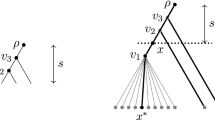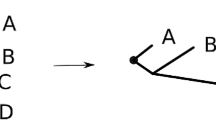Abstract
Reconstructing evolutionary trees from molecular sequence data is a fundamental problem in computational biology. Stochastic models of sequence evolution are closely related to spin systems that have been extensively studied in statistical physics and that connection has led to important insights on the theoretical properties of phylogenetic reconstruction algorithms as well as the development of new inference methods. Here, we study maximum likelihood, a classical statistical technique which is perhaps the most widely used in phylogenetic practice because of its superior empirical accuracy. At the theoretical level, except for its consistency, that is, the guarantee of eventual correct reconstruction as the size of the input data grows, much remains to be understood about the statistical properties of maximum likelihood in this context. In particular, the best bounds on the sample complexity or sequence-length requirement of maximum likelihood, that is, the amount of data required for correct reconstruction, are exponential in the number, n, of tips—far from known lower bounds based on information-theoretic arguments. Here we close the gap by proving a new upper bound on the sequence-length requirement of maximum likelihood that matches up to constants the known lower bound for some standard models of evolution. More specifically, for the r-state symmetric model of sequence evolution on a binary phylogeny with bounded edge lengths, we show that the sequence-length requirement behaves logarithmically in n when the expected amount of mutation per edge is below what is known as the Kesten-Stigum threshold. In general, the sequence-length requirement is polynomial in n. Our results imply moreover that the maximum likelihood estimator can be computed efficiently on randomly generated data provided sequences are as above. Our main technical contribution, which may be of independent interest, relates the total variation distance between the leaf state distributions of two trees with a notion of combinatorial distance between the trees. In words we show in a precise quantitative manner that the more different two evolutionary trees are, the easier it is to distinguish their output.








Similar content being viewed by others
References
Allen, B.L., Steel, M.: Subtree transfer operations and their induced metrics on evolutionary trees. Ann. Comb. 1, 1–15 (2001)
Andoni, A., Daskalakis, C., Hassidim, A., Roch, S.: Global alignment of molecular sequences via ancestral state reconstruction. Stoch. Process. Appl. 122(12), 3852–3874 (2012)
Borgs, C., Chayes, J., Mossel, E., Roch, S.: The Kesten-Stigum reconstruction bound is tight for roughly symmetric binary channels. In: FOCS, pp. 518–530 (2006)
Brown, D.G., Truszkowski, J.: Fast phylogenetic tree reconstruction using locality-sensitive hashing. In: Algorithms in Bioinformatics, pp 14–29. Springer (2012)
Cavender, J.A.: Taxonomy with confidence. Math. Biosci. 40(3–4), 271–280 (1978)
Cryan, M., Goldberg, L.A., Goldberg, P.W.: Evolutionary trees can be learned in polynomial time. SIAM J. Comput. 31(2), 375–397 (2002). Short version In: Proceedings of the 39th Annual Symposium on Foundations of Computer Science (FOCS 98), pp. 436–445 (1998)
Chang, J.T.: Full reconstruction of Markov models on evolutionary trees: identifiability and consistency. Math. Biosci. 137(1), 51–73 (1996)
Chor, B., Tuller, T.: Finding a maximum likelihood tree is hard. J. ACM 53(5), 722–744 (2006)
Choi, M.J., Tan, V.Y., Anandkumar, A., Willsky, A.S.: Learning latent tree graphical models. J. Mach. Learn. Res. 12, 1771–1812 (2011)
Daskalakis, C., Mossel, E., Roch, S.: Evolutionary trees and the ising model on the Bethe lattice: a proof of Steel’s conjecture. Probab. Theory Relat. Fields 149, 149–189 (2011). doi:10.1007/s00440-009-0246-2
Daskalakis, C., Mossel, E., Roch, S.: Phylogenies without branch bounds: contracting the short, pruning the deep. SIAM J. Discret. Math. 25(2), 872–893 (2011)
Daskalakis, C., Roch, S.: Alignment-free phylogenetic reconstruction: sample complexity via a branching process analysis. Ann. Appl. Probab. 23(2), 693–721 (2013)
Deonier, R.C., Tavaré, S., Waterman, M.S.: Computational Genome Analysis: An Introduction. Springer, New York (2005)
Evans, W.S., Kenyon, C., Peres, Y., Schulman, L.J.: Broadcasting on trees and the Ising model. Ann. Appl. Probab. 10(2), 410–433 (2000)
Erdös, P.L., Steel, M.A., Székely, L.A., Warnow, T.A.: A few logs suffice to build (almost) all trees (part 1). Random Struct. Algorithms 14(2), 153–184 (1999)
Erdös, P.L., Steel, M.A., Székely, L.A., Warnow, T.A.: A few logs suffice to build (almost) all trees (part 2). Theor. Comput. Sci. 221, 77–118 (1999)
Farris, J.S.: A probability model for inferring evolutionary trees. Syst. Zool. 22(4), 250–256 (1973)
Felsenstein, J.: Evolutionary trees from dna sequences: a maximum likelihood approach. J. Mol. Evol. 17, 368–376 (1981)
Felsenstein, J.: Inferring Phylogenies. Sinauer, Sunderland (2004)
Georgii, H.O.: Gibbs Measures and Phase Transitions, Volume 9 of de Gruyter Studies in Mathematics. Walter de Gruyter & Co., Berlin (1988)
Guindon, S., Lethiec, F., Duroux, P., Gascuel, O.: PHYML online web server for fast maximum likelihood-based phylogenetic inference. Nucl. Acids Res. 33(suppl 2), W557–W559 (2005)
Gronau, I., Moran, S., Snir, S.: Fast and reliable reconstruction of phylogenetic trees with indistinguishable edges. Random Struct. Algorithms 40(3), 350–384 (2012)
Grimmett, G.: The Random-Cluster Model, Volume 333 of Grundlehren der Mathematischen Wissenschaften [Fundamental Principles of Mathematical Sciences]. Springer, Berlin (2006)
Huson, D.H., Nettles, S.H., Warnow, T.J.: Disk-covering, a fast-converging method for phylogenetic tree reconstruction. J. Comput. Biol. 6(3–4), 369–386 (1999)
Ioffe, D.: On the extremality of the disordered state for the Ising model on the Bethe lattice. Lett. Math. Phys. 37(2), 137–143 (1996)
Jukes, T.H., Cantor, C.: Mammalian protein metabolism. In: Munro, H.N. (ed.) Evolution of Protein Molecules, pp. 21–132. Academic Press, Cambridge (1969)
Janson, S., Mossel, E.: Robust reconstruction on trees is determined by the second eigenvalue. Ann. Probab. 32, 2630–2649 (2004)
Kesten, H., Stigum, B.P.: Additional limit theorems for indecomposable multidimensional Galton-Watson processes. Ann. Math. Stat. 37, 1463–1481 (1966)
Lacey, M.R., Chang, J.T.: A signal-to-noise analysis of phylogeny estimation by neighbor-joining: insufficiency of polynomial length sequences. Math. Biosci. 199(2), 188–215 (2006)
Liggett, T.M.: Interacting Particle Systems, Volume 276 of Grundlehren der Mathematischen Wissenschaften [Fundamental Principles of Mathematical Sciences]. Springer, New York (1985)
Lehmann, E.L., Romano, J.P.: Testing Statistical Hypotheses (Springer Texts in Statistics), 3rd edn. Springer, New York (2005)
Mihaescu, R., Hill, C., Rao, S.: Fast phylogeny reconstruction through learning of ancestral sequences. Algorithmica 66(2), 419–449 (2013)
Mossel, E.: Reconstruction on trees: beating the second eigenvalue. Ann. Appl. Probab. 11(1), 285–300 (2001)
Mossel, E.: On the impossibility of reconstructing ancestral data and phylogenies. J. Comput. Biol. 10(5), 669–678 (2003)
Mossel, E.: Phase transitions in phylogeny. Trans. Am. Math. Soc. 356(6), 2379–2404 (2004)
Mossel, E.: Survey: information flow on trees. In: Nestril, J., Winkler, P. (eds.) Graphs, Morphisms and Statistical Physics, pp. 155–170. American Mathematical Society, Providence (2004)
Mossel, E.: Distorted metrics on trees and phylogenetic forests. IEEE/ACM Trans. Comput. Biol. Bioinform. 4(1), 108–116 (2007)
Motwani, R., Raghavan, P.: Randomized Algorithms. Cambridge University Press, Cambridge (1995)
Mossel, E., Roch, S.: Learning nonsingular phylogenies and hidden Markov models. Ann. Appl. Probab. 16(2), 583–614 (2006)
Mossel, E., Roch, S.: Phylogenetic mixtures: concentration of measure in the large-tree limit. Ann. Appl. Probab. 22(6), 2429–2459 (2012)
Mossel, E., Roch, S.: Identifiability and inference of non-parametric rates-across-sites models on large-scale phylogenies. J. Math. Biol. 67(4), 767–797 (2013)
Mossel, E., Roch, S., Sly, A.: On the inference of large phylogenies with long branches: How long is too long? Bull. Math. Biol. 73, 1627–1644 (2011). doi:10.1007/s11538-010-9584-6
Neyman, J.: Molecular studies of evolution: a source of novel statistical problems. In: Gupta, S.S., Yackel, J. (eds.) Statistical Desicion Theory and Related Topics, pp. 1–27. Academic Press, New York (1971)
Peres, Y.: Probability on trees: an introductory climb. In: Lectures on Probability Theory and Statistics (Saint-Flour, 1997). Lecture Notes in Math, vol. 1717, pp. 193–280. Springer, Berlin (1999)
Roch, S.: A short proof that phylogenetic tree reconstruction by maximum likelihood is hard. IEEE/ACM Trans. Comput. Biol. Bioinform. 3(1), 92–94 (2006)
Roch, S.: Sequence length requirement of distance-based phylogeny reconstruction: breaking the polynomial barrier. In: FOCS, pp. 729–738 (2008)
Roch, S.: Toward extracting all phylogenetic information from matrices of evolutionary distances. Science 327(5971), 1376–1379 (2010)
Sly, A.: Reconstruction for the potts model. In: STOC, pp. 581–590 (2009)
Saitou, N., Nei, M.: The neighbor-joining method: a new method for reconstructing phylogenetic trees. Mol. Biol. Evol. 4(4), 406–425 (1987)
Steel, M.A., Székely, L.A.: Inverting random functions. II. Explicit bounds for discrete maximum likelihood estimation, with applications. SIAM J. Discret. Math. 15(4), 562–575 (2002)
Semple, C., Steel, M.: Phylogenetics, Volume 22 of Mathematics and Its Applications Series. Oxford University Press, Oxford (2003)
Steel, M.A., Székely, L.A.: On the variational distance of two trees. Ann. Appl. Probab. 16(3), 1563–1575 (2006)
Smith, S.A., Stamatakis, A.: Inferring and postprocessing huge phylogenies. In: Elloumi, M., Zomaya, A.Y. (eds.) Biological Knowledge Discovery Handbook: Preprocessing, Mining, and Postprocessing of Biological Data. Wiley, Hoboken (2013). doi:10.1002/9781118617151.ch46
Stamatakis, A.: RAxML-VI-HPC: maximum likelihood-based phylogenetic analyses with thousands of taxa and mixed models. Bioinformatics 22(21), 2688–2690 (2006)
Steel, M.: Recovering a tree from the leaf colourations it generates under a Markov model. Appl. Math. Lett. 7(2), 19–23 (1994)
Steel, M.: My Favourite Conjecture (2001) (unpublished)
Steel, M.: Phylogeny—Discrete and Random Processes in Evolution, Volume 89 of CBMS-NSF Regional Conference Series in Applied Mathematics. Society for Industrial and Applied Mathematics (SIAM), Philadelphia (2016)
Tan, V.Y.F., Anandkumar, A., Tong, L., Willsky, A.S.: A large-deviation analysis of the maximum-likelihood learning of Markov tree structures. IEEE Trans. Inform. Theory 57(3), 1714–1735 (2011)
Tan, V.Y.F., Anandkumar, A., Willsky, A.S.: Learning high-dimensional markov forest distributions. J. Mach. Learn. Res. 12, 1617–1653 (2011)
Wald, A.: Note on the consistency of the maximum likelihood estimate. Ann. Math. Stat. 20, 595–601 (1949)
Warnow, T.: Computational Phylogenetics: An Introduction to Designing Methods for Phylogeny Estimation. To be published by Cambridge University Press, Cambridge (2017)
Acknowledgements
We thank the anonymous reviewers of a previous version for helpful comments.
Author information
Authors and Affiliations
Corresponding author
Additional information
2016 Wolfgang Doeblin Prize Article.
Sebastien Roch: Work partly done at Microsoft Research, UCLA, IPAM and the Simons Institute for the Theory of Computing. Work supported by NSF Grants DMS-1007144 and DMS-1149312 (CAREER), and an Alfred P. Sloan Research Fellowship.
Allan Sly: Work partly done at Microsoft Research. Work supported by NSF Grants DMS-1208339 and DMS-1352013 and an Alfred P. Sloan Research Fellowship.
Preliminary lemmas
Preliminary lemmas
In this section, we collect a few useful lemmas.
1.1 Ancestral reconstruction
An important part of our construction involves reconstructing ancestral states. We will use the following lemma from [14] which we typically apply to a rooted subtree. Let \(T = (V,E;\phi ;w) \in \mathbb {Y}\) rooted at \(\rho \). Let \(e = (x,y) \in E\) and assume that x is closest to \(\rho \) (in topological distance). We define \(\mathrm {P}(\rho ,e) = \mathrm {P}(\rho ,y)\), \(|e|_\rho = |\mathrm {P}(\rho ,e)|\), and
where \(\Theta _{\rho ,y} = e^{-\mathrm {d}_T(\rho ,y)}\) and \(\theta _e = e^{-w_e}\).
Lemma 2
(Ancestral reconstruction [14]) For any unit flow \(\Psi \) from \(\rho \) to [n],
where the LHS is the difference between the probability of correct and incorrect reconstruction using MLE. (See [14, Equation (14), Lemma 5.1 and Theorem 1.2’].)
1.2 Random cluster representation
We use a convenient percolation-based representation of the CFN model known as the random cluster model (see e.g. [23]). Let \(T = (V,E;\phi ;w) \in \mathbb {Y}\) with corresponding \((\delta _e)_{e\in E}\).
Lemma 3
(Random cluster representation) Run a percolation process on T where edge e is open with probability \(1 - 2 \delta _e\). Then associate to each open connected component a state according to the uniform distribution on \(\{+1,-1\}\). The state vector on the vertices so obtained \((\sigma _v)_{v\in V}\) has the same distribution as the corresponding CFN model.
1.3 Concentration inequalities
Recall the following standard concentration inequality (see e.g. [38]):
Lemma 4
(Azuma-Hoeffding Inequality) Suppose \(\mathbf{Z}=(Z_1,\ldots ,Z_m)\) are independent random variables taking values in a set S, and \(h:S^m \rightarrow \mathbb {R}\) is any t-Lipschitz function: \(|h(\mathbf{z}) - h(\mathbf{z'})|\le t\) whenever \(\mathbf{z}, \mathbf{z'} \in S^m\) differ at just one coordinate. Then, \(\forall \zeta > 0\),
Rights and permissions
About this article
Cite this article
Roch, S., Sly, A. Phase transition in the sample complexity of likelihood-based phylogeny inference. Probab. Theory Relat. Fields 169, 3–62 (2017). https://doi.org/10.1007/s00440-017-0793-x
Received:
Revised:
Published:
Issue Date:
DOI: https://doi.org/10.1007/s00440-017-0793-x




